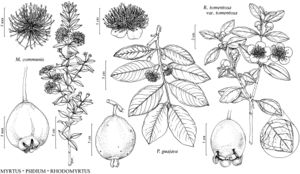Psidium guajava
Sp. Pl. 1: 470. 1753.
Shrubs or trees to 8 m; trunk light-brown, reddish-brown, or light grayish green, mostly smooth, with large, flaky scales; young twigs green, quadrangular, slightly to strongly winged, often sulcate, at least when dry, older twigs reddish-brown to grayish green, smooth or scaly; young growth glabrate to densely appressed-pubescent, hairs whitish, yellowish, or silvery, to ca. 0.7 mm. Leaves: petiole channeled, 2–5 × 1–2 mm, densely pubescent to glabrate; blade drying yellowish green, grayish green, or reddish-brown, elliptic, oblong, elliptic-oblanceolate, elliptic-obovate, or lanceolate, 4.5–14 × 2.4–7.5 cm, 1.6–3.8 times as long as wide, leathery to submembranous, midvein prominent abaxially, impressed adaxially, lateral-veins 9–22 pairs, prominent, ascending (at ca. 45°), nearly straight, curving upward near margin and connecting with next lateral-vein, smaller veins connecting laterals in ladderlike to reticulate pattern, base rounded to slightly cordate, apex acute, acuminate, or rounded, surfaces densely to sparsely appressed-pubescent abaxially, glabrate adaxially (except midvein puberulent). Peduncles 1–3.5 cm × 1–1.5 mm, terete. Inflorescences 1-flowered or 3-flowered, borne in leaf-axils; bracteoles linearto narrowly triangular, 2–5 mm, sparsely pubescent. Flowers: bud subfusiform to pyriform, 10–17 mm, sometimes strongly constricted near midpoint, apex usually conic; hypanthium to summit of ovary obconic, ca. 1/2 as long as closed flower bud; calyx closed, conicin bud, tearing irregularly as bud opens, persisting or falling in ca. 3 parts; petals obovate to elliptic, 13–22 mm; disc 4–6 mm across; stamens 280–720,7–15 mm; anthers 0.7–1 mm; style 10–15 mm; stigma ca. 0.5 mm wide; ovary 3–6-locular; ovules 90–180 per locule (multiseriate). Berries aromatic, green or yellow, with pink or white flesh inside, globose or pyriform, 20–60 (–80) mm. Seeds usually 50+, subreniform,3–4 mm, ± smooth.
Phenology: Flowering spring.
Habitat: Roadsides, pastures, riparian areas.
Elevation: 0–100 m.
Distribution
Introduced; Fla., La., South America, also in tropics and subtropics worldwide
Discussion
Psidium guajava is known in the flora area from the central and southern peninsula in Florida and Jefferson Parish in Louisiana.
Psidium guajava is commonly and widely cultivated for its edible fruit. It probably was originally cultivated in tropical South America. Archaeological evidence of guava cultivation has been reported for coastal Peru at about 4000 years ago (R. Shady-Solis et al. 2001) and even earlier in Rondônia, Brazil (J. Watling et al. 2018). In Central America and Mexico, the earliest archaeological find of P. guajava is about 2000 years old in the Tehuacán Valley of Mexico (C. E. Smith 1965). It reached the Caribbean Islands in pre-Columbian times (G. Fernández de Oviedo y Valdéz 1851). How much of the American distribution, which now extends from Mexico to Argentina, is due to the actions of humans is uncertain. In post-Columbian times it was rapidly spread to the tropical and subtropical regions around the world. Guava products are imported into the United States mainly from Brazil, Dominican Republic, Egypt, Mexico, Philippines, Taiwan, and Thailand. The leaves and bark are commonly used medicinally as a tea to remedy diarrhea.
Psidium guineense Swartz, common in tropical and subtropical America, is a similar weedy species that is often confused with P. guajava. One specimen collected at Bradenton, Florida, in 1916 has been seen; it may be expected in the southeastern United States. Psidium guineense differs from P. guajava in having leaves with fewer lateral veins, usually erect, reddish brown (not appressed and whitish) hairs on the abaxial surfaces, anthers 1–3 mm, and a calyx that tears in usually five (not three) segments.
Selected References
None.
